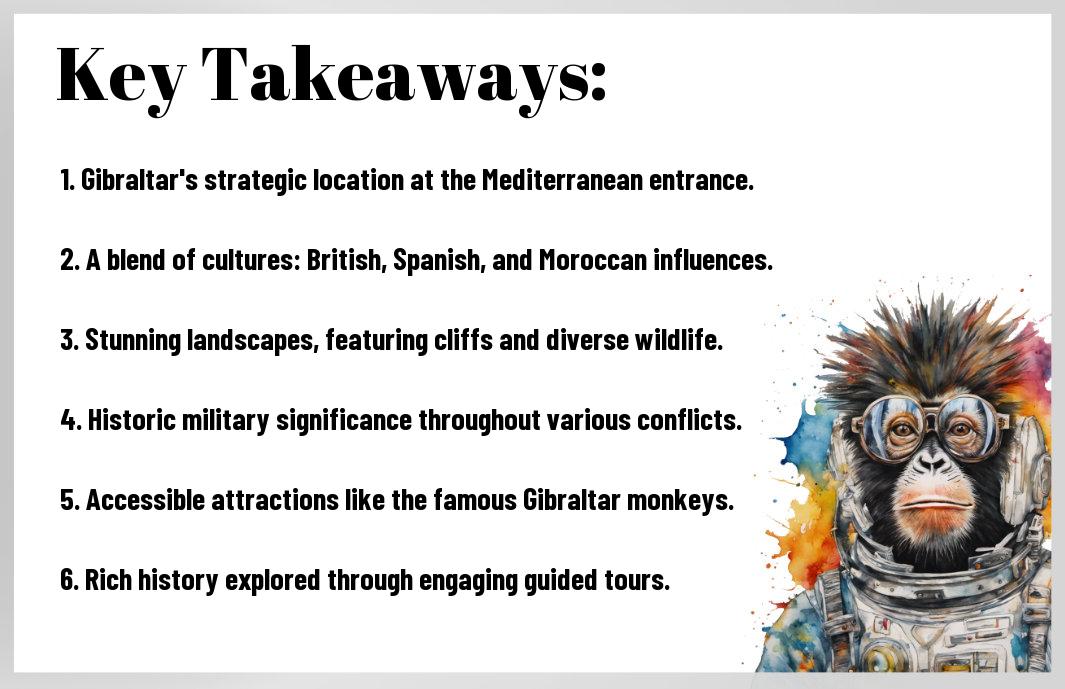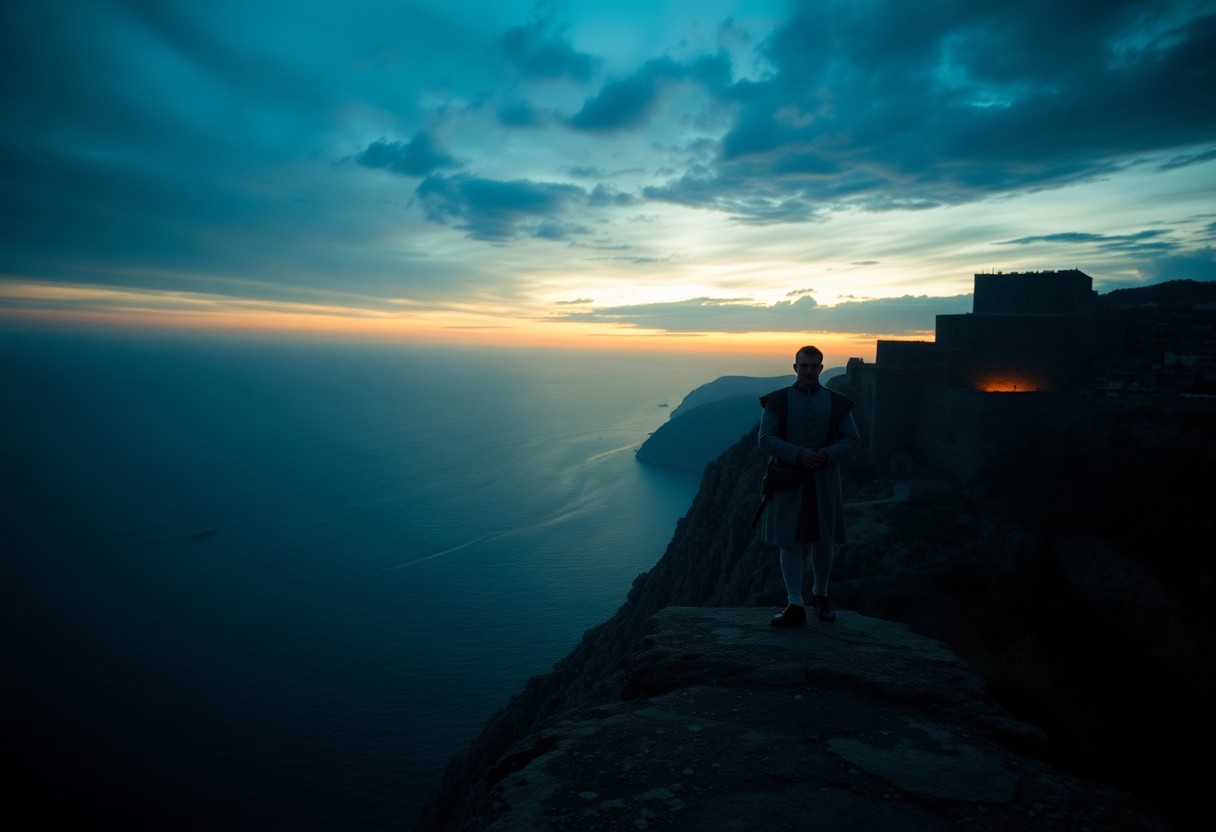Journey into the storied past of Gibraltar, a majestic landmark that has stood witness to centuries of history. With Jesper Jacobi as your guide, you will explore the rich tapestry of cultures, conflicts, and events that have shaped this iconic rock. Delve into its strategic significance, panoramic views, and the intriguing stories of the people who have inhabited this unique territory. As you learn about Gibraltar’s evolution, you will gain a deeper appreciation for its place in both local and global history.

The Strategic Location and Early History
Your journey through Gibraltar’s rich history begins with an exploration of its strategic location. Situated at the entrance of the Mediterranean Sea, Gibraltar has long served as a pivotal point for trade and military movements. This advantageous positioning has made it a focal point for numerous civilizations, all vying for control over this necessary gateway between Europe and Africa.
Geographic Significance
Location plays a significant role in Gibraltar’s historical importance. Overlooking the Strait of Gibraltar, it controls passage between the Mediterranean and the Atlantic Ocean. This makes it a landmark for navigators and a coveted asset for empires throughout history.
Ancient Civilizations and Early Settlements
For centuries, various cultures have settled in Gibraltar, leveraging its unique geographic advantages. From the Phoenicians and Carthaginians to the Romans, each group recognized the strategic importance of the Rock, using it as a trading post and military stronghold.
Consequently, these early civilizations shaped the trajectory of Gibraltar’s development. The Phoenicians established trade networks that extended across the Mediterranean, laying the groundwork for future inhabitants. When the Romans arrived, they fortified Gibraltar to safeguard maritime routes. Each settlement contributed layers of history that continue to influence this iconic landmark today.
British Gibraltar
One of the most fascinating aspects of Gibraltar’s history is its transformation into a British territory. Established in 1704 during the War of the Spanish Succession, British Gibraltar has played a pivotal role in naval power and commerce throughout the centuries. You can explore how this small piece of land has influenced geopolitical strategies and international relations, making it a unique intersection of cultures and histories.
Treaty of Utrecht and British Control
Any exploration of British Gibraltar must begin with the Treaty of Utrecht in 1713, which formally ceded the territory to Britain. This agreement marked a significant turning point, granting Britain control of Gibraltar in exchange for recognizing Spanish sovereignty over other territories. You will want to understand how this treaty laid the groundwork for the military and economic importance of Gibraltar to the British Empire.
Military Significance Through the Ages
By the 18th and 19th centuries, Gibraltar emerged as a strategic military stronghold, guarding the entrance to the Mediterranean Sea. Its position allowed British forces to monitor naval movements and project power. You can appreciate how its fortifications evolved over time, enhancing its defensive capabilities against potential invaders.
This military significance continued into the 20th century, particularly during both World Wars. Gibraltar served as a base for Allied operations, providing crucial support for naval logistics and protecting maritime routes. You can research deeper into how these historical events shaped Gibraltar’s identity and solidified its status as a military bastion in British history.
Natural Heritage
Many visitors to Gibraltar are captivated by its stunning natural heritage, which encompasses both breathtaking landscapes and a rich tapestry of biodiversity. As you explore this unique location, you will encounter remarkable geological formations, exceptional flora, and a variety of endemic species that contribute to the Rock’s distinctive ecosystem. Each aspect of Gibraltar’s natural heritage tells a story, revealing how this small territory has remained a vital refuge for wildlife and a vibrant part of the Mediterranean’s ecological network.
The Rock Formation and Geology
Against the backdrop of the Mediterranean landscape, the Rock of Gibraltar stands as a testament to the geological history of the region. Formed primarily of limestone, it showcases a complex array of rock formations that span millions of years. While you walk its trails, you can observe fascinating karst features, such as caves and sinkholes, shaped by the weathering processes of wind and rain. This geological marvel not only offers breathtaking views but also serves as a reminder of the dynamic forces that have shaped our planet.
Gibraltar’s Unique Flora and Fauna
Before you research deeper into the natural wonders of Gibraltar, it’s important to appreciate the diverse flora and fauna that thrive in this distinct environment. The Rock serves as a critical habitat for numerous species, many of which are found nowhere else in the world. As you navigate its trails, you’ll discover endemic plants and the iconic Barbary macaques, which are the only wild monkeys in Europe.
Indeed, Gibraltar’s unique flora and fauna are a vital part of its ecological identity. The Mediterranean climate supports a mix of habitats, including scrubland, woodlands, and coastal areas where diverse plant species flourish. You may encounter rare flowers like the Gibraltar campion and the unique trailing rock rose. Additionally, the famous Barbary macaques will likely catch your attention; these fascinating creatures roam freely on the Rock, offering you a glimpse into a world where wildlife and human history intertwine. Your exploration will deepen your appreciation for Gibraltar’s role as a haven for both plant and animal life.
Cultural Mosaic
To truly appreciate Gibraltar is to recognize its rich cultural mosaic, shaped by centuries of diverse influences. The blending of various traditions, languages, and cuisines creates a unique atmosphere that reflects the historical layers of this prominent landmark. As you explore Gibraltar, you will find remnants of its past coexisting beautifully with modern life, offering insight into the vibrant identity of its people.
Diverse Population and Influences
To comprehend Gibraltar’s cultural identity, you must probe into its diverse population and the myriad influences that have shaped it. With a mix of British, Spanish, Italian, and various Mediterranean cultures, you’ll find a unique harmony among communities. This fusion is evident in the languages spoken, the foods enjoyed, and the celebrations observed throughout the year.
Local Traditions and Customs
For anyone visiting Gibraltar, engaging with local traditions and customs is a vital part of understanding the community’s genuine spirit. Unique festivals and events showcase the region’s rich heritage, allowing you to immerse yourself in the local way of life, from food to dance to music.
Traditions in Gibraltar often reflect its multicultural roots, with celebrations such as the National Day featuring vibrant parades and the Festival of Saint Bernard showcasing local music and dance. You will also discover culinary customs that highlight the diverse influences, including a mix of Mediterranean and British dishes. Engaging with locals during these occasions will enrich your experience and deepen your appreciation for Gibraltar’s vibrant cultural landscape.
Modern Gibraltar
Despite its small size, Gibraltar plays a significant role in contemporary geopolitics and economics. The unique blend of British heritage and Mediterranean culture continues to shape the identity of this vibrant territory. You will find that modern infrastructure coexists with historical landmarks, providing both residents and visitors a dynamic experience. As you explore, you’ll uncover how Gibraltar has adapted to current global challenges while maintaining its rich past.
Economic Development and Tourism
Against a backdrop of stunning landscapes, Gibraltar has seen substantial economic growth, largely driven by tourism. You may discover that visitors are drawn to its unique history, natural beauty, and recreational activities. The government’s efforts to diversify the economy have also led to improvements in financial services and online gaming, enhancing Gibraltar’s profile as a sought-after destination.
Political Status and Relations
Tourism remains a significant aspect of Gibraltar’s identity, yet its political status adds complexity to its relations with neighboring Spain. You’ll notice that the sovereignty of Gibraltar has been a longstanding contentious issue. Following Brexit, this has further influenced discussions between the British Overseas Territory and the European Union, creating a dynamic environment that impacts both governance and local sentiment.
The ongoing discussions about Gibraltar’s political status indicate a profound connection between its residents and their British heritage, juxtaposed with a desire for better relations with Spain. As you investigate deeper into these intricacies, you might find that the people of Gibraltar have a strong sense of identity, forging a path that balances their unique historical context with current political realities. The interactions between Gibraltar and Spain reveal the complexities of sovereignty, regional collaboration, and the aspirations of those who call this iconic territory home.
Notable Landmarks
Unlike many other destinations, Gibraltar boasts unique landmarks steeped in history. From its impressive rock formations to its centuries-old buildings, you can explore a range of sites that tell the story of this fascinating territory. A visit to The Rock of Gibraltar reveals an interesting history that encapsulates both military significance and cultural diversity.
St. Michael’s Cave and Great Siege Tunnels
Notable for their breathtaking beauty and historical importance, St. Michael’s Cave and the Great Siege Tunnels are must-see attractions. You will find St. Michael’s Cave, a stunning limestone cavern adorned with dramatic stalactites and stalagmites, offering guided tours that highlight its history and geological wonder.
Europa Point and Moorish Castle
After exploring the cavern, you should head to Europa Point and Moorish Castle. Europa Point is the southernmost point of Gibraltar and provides panoramic views of the Mediterranean Sea, while the Moorish Castle, built during the 8th century, stands as a testament to the region’s historical significance and architectural heritage.
This remarkable castle not only offers a glimpse into Gibraltar’s storied past but also serves as an astonishing backdrop for photographs. At Europa Point, the lighthouse and views of the Spanish coast create a sense of tranquility, allowing you to reflect on the layers of history encapsulated in the landscape while enjoying the sea breeze.
Summing up
Conclusively, your journey through “The Rock of Gibraltar – A Journey Through History with Jesper Jacobi” unveils the fascinating layers of this strategic landmark. You gain insight into its rich history, from ancient times to its role in modern geopolitics. As you explore its unique significance, you not only appreciate its natural beauty but also understand the cultural and historical narratives that shape Gibraltar today. This journey enhances your awareness and appreciation of the complex tapestry that defines this iconic location.




